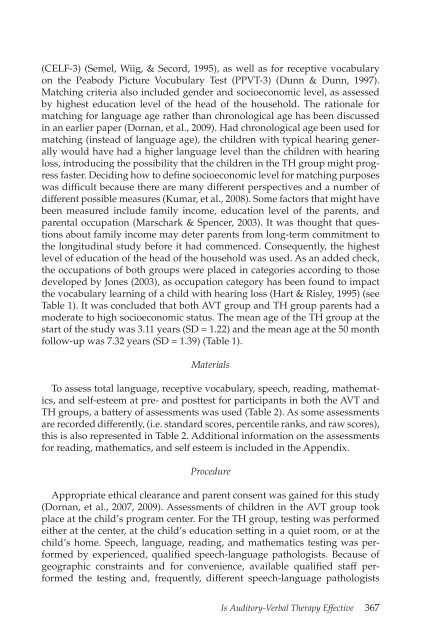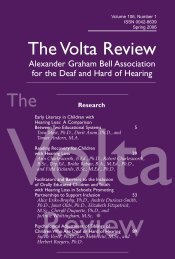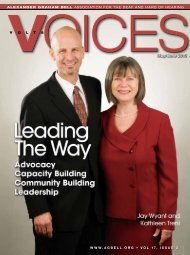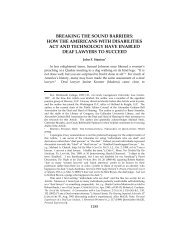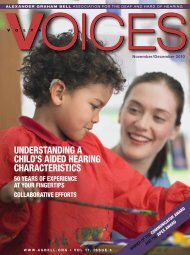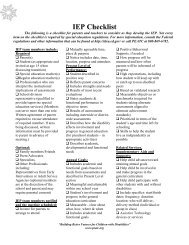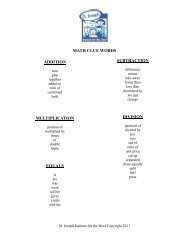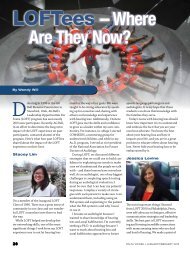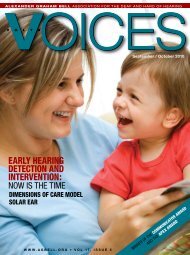Download this issue - Alexander Graham Bell Association
Download this issue - Alexander Graham Bell Association
Download this issue - Alexander Graham Bell Association
Create successful ePaper yourself
Turn your PDF publications into a flip-book with our unique Google optimized e-Paper software.
(CELF-3) (Semel, Wiig, & Secord, 1995), as well as for receptive vocabulary<br />
on the Peabody Picture Vocubulary Test (PPVT-3) (Dunn & Dunn, 1997).<br />
Matching criteria also included gender and socioeconomic level, as assessed<br />
by highest education level of the head of the household. The rationale for<br />
matching for language age rather than chronological age has been discussed<br />
in an earlier paper (Dornan, et al., 2009). Had chronological age been used for<br />
matching (instead of language age), the children with typical hearing generally<br />
would have had a higher language level than the children with hearing<br />
loss, introducing the possibility that the children in the TH group might progress<br />
faster. Deciding how to define socioeconomic level for matching purposes<br />
was difficult because there are many different perspectives and a number of<br />
different possible measures (Kumar, et al., 2008). Some factors that might have<br />
been measured include family income, education level of the parents, and<br />
parental occupation (Marschark & Spencer, 2003). It was thought that questions<br />
about family income may deter parents from long-term commitment to<br />
the longitudinal study before it had commenced. Consequently, the highest<br />
level of education of the head of the household was used. As an added check,<br />
the occupations of both groups were placed in categories according to those<br />
developed by Jones (2003), as occupation category has been found to impact<br />
the vocabulary learning of a child with hearing loss (Hart & Risley, 1995) (see<br />
Table 1 ). It was concluded that both AVT group and TH group parents had a<br />
moderate to high socioeconomic status. The mean age of the TH group at the<br />
start of the study was 3.11 years (SD = 1.22) and the mean age at the 50 month<br />
follow-up was 7.32 years (SD = 1.39) ( Table 1 ).<br />
Materials<br />
To assess total language, receptive vocabulary, speech, reading, mathematics,<br />
and self-esteem at pre- and posttest for participants in both the AVT and<br />
TH groups, a battery of assessments was used ( Table 2 ). As some assessments<br />
are recorded differently, (i.e. standard scores, percentile ranks, and raw scores),<br />
<strong>this</strong> is also represented in Table 2 . Additional information on the assessments<br />
for reading, mathematics, and self esteem is included in the Appendix.<br />
Procedure<br />
Appropriate ethical clearance and parent consent was gained for <strong>this</strong> study<br />
(Dornan, et al., 2007, 2009). Assessments of children in the AVT group took<br />
place at the child’s program center. For the TH group, testing was performed<br />
either at the center, at the child’s education setting in a quiet room, or at the<br />
child’s home. Speech, language, reading, and mathematics testing was performed<br />
by experienced, qualified speech-language pathologists. Because of<br />
geographic constraints and for convenience, available qualified staff performed<br />
the testing and, frequently, different speech-language pathologists<br />
Is Auditory-Verbal Therapy Effective 367


